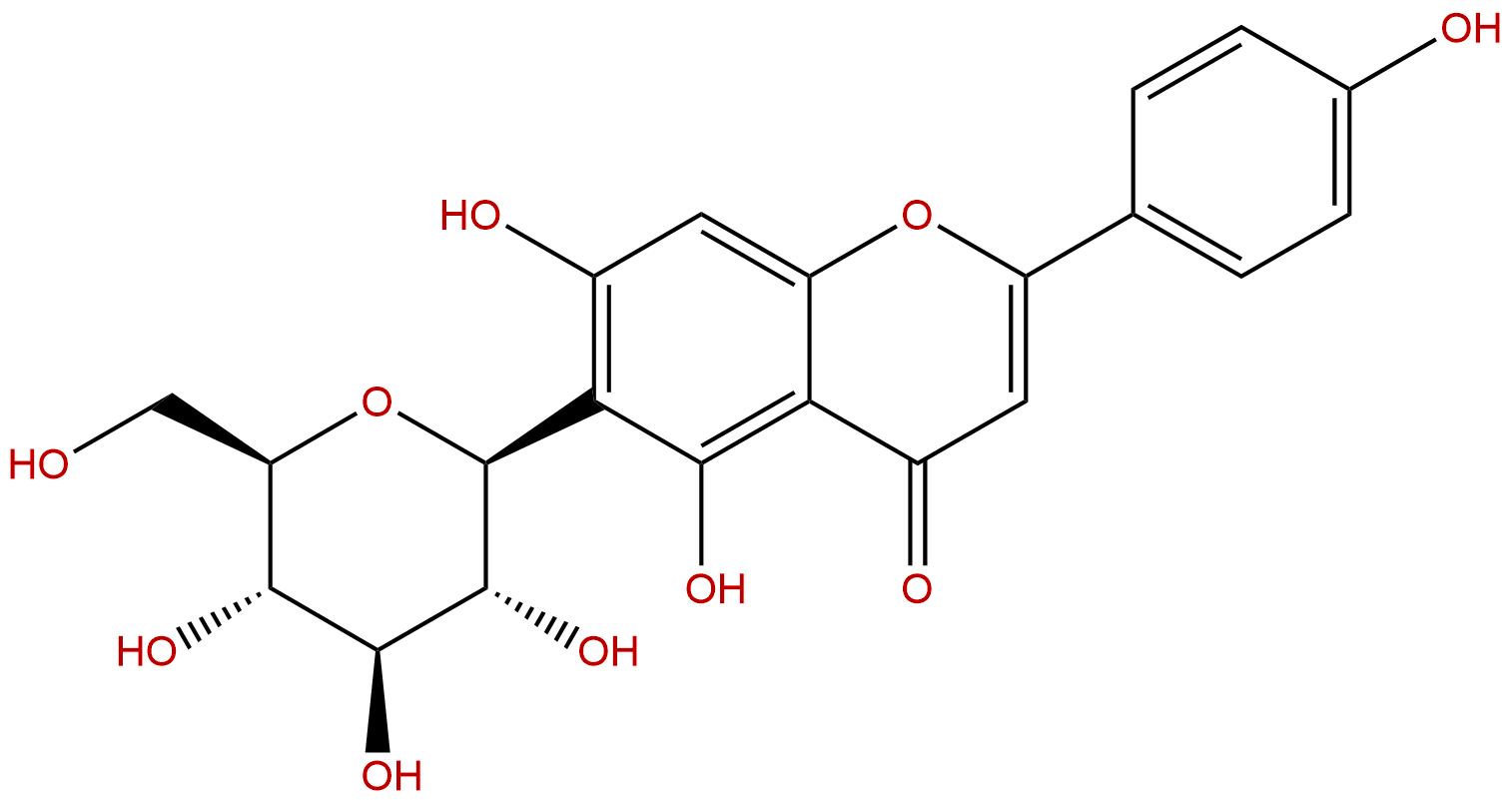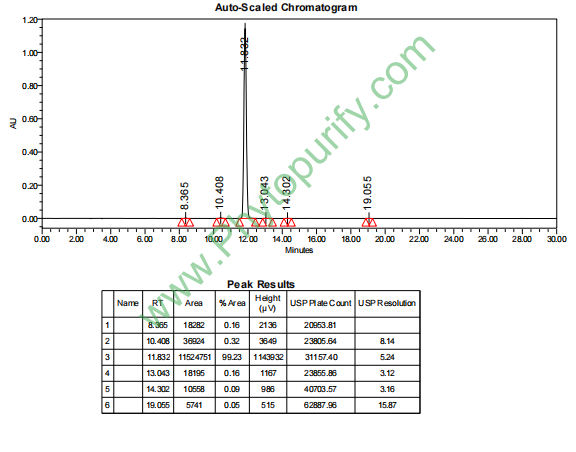
IsovitexinCAS No.:38953-85-4
|
||||||||||
 |
|
|
||||||||

| Catalogue No.: | BP0804 |
| Formula: | C21H20O10 |
| Mol Weight: | 432.381 |
Product name: Isovitexin
Synonym name: 6-Glucosylapigenin; Saponaretin; Homovitexin; Avroside
Catalogue No.: BP0804
Cas No.: 38953-85-4
Formula: C21H20O10
Mol Weight: 432.381
Botanical Source: Lophatherum gracile Brongn.
Physical Description:
Type of Compound: Flavonoids
Purity: 95%~99%
Analysis Method: HPLC-DAD or/and HPLC-ELSD
Identification Method: Mass, NMR
Packing: Brown vial or HDPE plastic bottle
Storage: Store in a well closed container, protected from air and light. Put into refrigerate or freeze for long term storage.
Whenever possible, you should prepare and use solutions on the same day. However, if you need to make up stock solutions in advance, we recommend that you store the solution as aliquots in tightly sealed vials at -20℃. Generally, these will be useable for up to two weeks.
The product could be supplied from milligrams to grams
Inquire for bulk scale.
Description:
Isovitexin, a food phytochemical contained in dietary rice products, it exhibits in vivo α-glucosidase inhibition, it possesses antihyperglycemic, neuroprotective, anti-inflammatory and anti-oxidant activities. Isovitexin inhibited xanthine oxidase with an IC50 value of 15.2 microM, it may protect cells from oxidative stress. It inhibited JNK, MAPK and NF-κB and activated HO-1/Nrf2 pathways.
References:
J Pharm Pharmacol. 2016 Feb;68(2):282-91.
Passiflora actinia hydroalcoholic extract and its major constituent, isovitexin, are neuroprotective against glutamate-induced cell damage in mice hippocampal slices.
To investigate whether Passiflora actinia hydroalcoholic extract and its major constituent, Isovitexin, protect mice hippocampal brain slices from glutamate-induced neurotoxicity.
METHODS AND RESULTS:
Neuroprotective effect of the extract against glutamate-induced excitotoxicity (10 mm) was evaluated through cell viability of hippocampal slices. The extract or its flavonoids were directly applied to hippocampal slices and then subjected to glutamate-induced toxicity. Alternatively, hippocampal slices from extract-treated mice were also subjected to the same toxicity protocol. Mice supplementation with the extract protected hippocampal slices from in-vitro neurotoxicity. When directly applied to hippocampal slices, the extract showed a higher neuroprotective potential than a commercial dry extract of Passiflora incarnata, which was related to P. actinia extract which had higher Isovitexin and total flavonoid content expressed as Isovitexin. Isovitexin, but not apigenin, induced a similar neuroprotective response when applied alone, at a concentration equivalent to that found in the extract.
CONCLUSIONS:
This study highlights new neuropharmacological activity of the Passiflora genus, suggesting that it can act as modulator of the glutamatergic system. The search for improved pharmacotherapies with novel mechanisms of action has been shown of great importance for the treatment of resistant neurological and psychiatric disorders.
Planta Med. 2005 Aug;71(8):748-53.
Isovitexin suppresses lipopolysaccharide-mediated inducible nitric oxide synthase through inhibition of NF-kappa B in mouse macrophages.
Isovitexin exhibits potent antioxidant activities. In this study, the activity of nitric oxide synthase (iNOS) in lipopolysaccharide (LPS)-activated RAW264.7 macrophages after incubation with Isovitexin was investigated.
METHODS AND RESULTS:
Isovitexin was able to reduce the production of hydrogen peroxide induced by LPS in mouse macrophage RAW264.7 cells. The cells incubated with Isovitexin had markedly reduced LPS-stimulated NO production with an IC (50) value of 58.5 microM. The expression of iNOS was also inhibited when the cells were treated with Isovitexin. A transient transfection experiment showed that Isovitexin suppressed the iNOS promoter and NF-kappaB-dependent transcriptional activities. It was also found to inhibit IKK kinase activity and prevent the degradation of IkappaBalpha in activated RAW264.7 cells. Additionally, Western blotting analysis revealed that Isovitexin prevented the translocation of NF-kappaB from the cytoplasm to the nucleus.
CONCLUSIONS:
Our results indicate that its ROS scavenger and IKK inhibitory activities also contribute to the suppression of ROS-mediated NF-kappaB activity. These results suggest that Isovitexin, a food phytochemical contained in dietary rice products, might have biological significance.
J Ethnopharmacol. 2012 Aug 1;142(3):776-81.
Vitexin and isovitexin from the Leaves of Ficus deltoidea with in-vivo α-glucosidase inhibition.
The leaves of Ficus deltoidea are used as a traditional medicine by diabetes patients in Malaysia. The objective of the study is to identify and evaluate bioactive constituents with in vivo α-glucosidase inhibition.
METHODS AND RESULTS:
The partitioned extracts, subfractions and pure bioactive constituents were subjected to α-glucosidase inhibition assay. The identified bioactive constituents were administered orally to sucrose loaded normoglycemic mice and induced diabetic rats. The postprandial blood glucose levels were monitored at 30 min interval. Acute toxicity was evaluated in both normoglycemic mice and induced diabetic rats. Bioactivity guided fractionation led to the isolation of both vitexin (1) and Isovitexin (2). Oral administration of 1mg/kg of either vitexin (1) or Isovitexin (2) significantly (p<0.05) reduced the postprandial blood glucose level in sucrose loaded normoglycemic mice at 30 min. The percentage of postprandial blood glucose reduction was highest in sucrose loaded induced diabetic rats administered orally with 200mg/kg of vitexin (1) or 100mg/kg of Isovitexin (2). Both vitexin (1) and Isovitexin (2) did not exert any signs of toxicity at the highest dose of 2g/kg administered orally to normoglycemic mice and induced diabetic rats.
CONCLUSIONS:
Both the C-glycosyl bioflavonoids, namely, vitexin (1) and Isovitexin (2) exhibited in vivo α-glucosidase inhibition.
HPLC of Isovitexin
